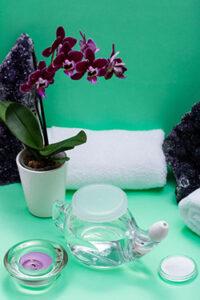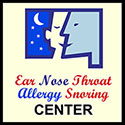Nasal Irrigation and Post OP Instructions
Nasal Irrigation
When performed regularly, nasal saline irrigations have been shown to reduce inflammation by cleansing mucous and irritants (including germs, pollen, dust, etc.) from your nasal cavities and sinuses. While beneficial for any patient regardless of surgical status, they are more effective at cleansing your sinuses after sinus surgery and may be used to deliver topical medications such as steroids and antibiotics. Nasal saline irrigations with, or without, medications may be recommended by your physician before considering surgery, during your surgical recovery, and often as an option for long-term symptom control in more severe cases of chronic sinusitis.
Tips for using nasal saline irrigations: 
- Always use sterile water. Distilled water is available at most grocery stores and is the safest option. Bottled water may suffice while traveling, but isn’t recommended long-term. Any other water source should be boiled for at least 3 to 5 minutes and cooled to a comfortable temperature prior to using in a nasal rinse. Saline rinses can be gently warmed in the microwave for comfort or used at room temperature.
- Use pre-mixed salt packets when available. Options include NielMed, Chito-Rhino, and others that may be available in pharmacies or online. It is possible to mix your own, and recipes generally include 2 or 3 teaspoons of non-iodized salt and ¼ to ½ teaspoons of baking soda in one liter of sterile water. Chito-Rhino may have added benefits compared to traditional pre-mixed salt packets, particularly if other options leave your nose feeling dry or irritated.
- Multiple different bottles and devices are available for nasal rinsing. Any of these should suffice if your goal is to improve mucous clearance and reduce inflammation. However, the squeeze bottles (ex. NielMed 240mL bottle) should be utilized for the various head positions needed to deliver medications into all sinuses (more info below). If rinses enter your ears or cause ear discomfort despite rinsing with your nose aimed at the floor and squeezing the bottle gently, this can often be avoided by using a suction-based device such as the Navage.
- After sinus surgery your surgeon may ask you to target specific sinuses with your rinsing to address problem areas noted on nasal endoscopy in the clinic. For rinsing frontal sinuses (forehead area), you should sit or lean forward with your nose aimed at the floor (chin to chest). For rinsing maxillary sinuses (in your cheeks), you should turn each cheek downward slightly while rinsing that side. For rinsing sphenoid sinuses (in the back of the sinus cavities), you should aim your nose upward at the ceiling while rinsing.
- Clean your rinsing bottle or device frequently by using a bottle brush with warm water and soap, a dishwasher (if non-powered), and/or filling it partially with sterile water and microwaving for 90 seconds. Biofilms may form over time and protect germs from these methods of cleansing. It is recommended that any sinus rinsing bottle be replaced every 3 months.
- If you are adding medications to your nasal rinses, remember to add the salt packet as well or the rinse may cause burning and irritation.
The following are medications that can be ordered from a compounding pharmacy for nasal rinses. This list is not comprehensive, but includes those used most often.
- Steroids: Budesonide, Mometasone, Fluticasone, Betamethasone, and more.
- Antibiotics: Amikacin, Azithromicin, Ciprofloxacin, Clindamycin, Doxycycline, Gentamicin, Levofloxacin, Mupirocin, Sulfamethoxazole-Trimethoprim (Bactrim, SMZ-TMP), Tobramycin, Vancomycin, and more.
- Antihistamines: Azelastine, Diphenhydramine (Benadryl)
- Mucolytic (thins mucous): Acetylcysteine
- Antifungals: Itraconazole, Nystatin, Amphotericin B
Use these instructions for Nasal Irrigation, if prescribed.
- 2 Teaspoons SALT
- 2 Teaspoons Baking Soda
- 2 Pints WARM WATER (Use DISTILLED Water ONLY!!)
Mix Together
OR USE NEILMED POWDER FOR “NORMAL SALINE” AVAILABLE AT THE PHARMACY AND FOLLOW THEIR DIRECTIONS
- 1 NASAL IRRIGATION DEVICE – (“SINUS RINSE” BOTTLE OR “NETI” POT)
- 1 EMESIS BASIN (OR PAN)
How to use
- Fill irrigation device with salt solution.
- Tilt head forward over basin and put irrigation tip in one nostril.
- Irrigate until solution returns clear through other nostril or mouth and repeat same procedure through other nostril.
- Use the same technique to irrigate nasal canaliculas (dressing tubes) with the soft catheter, supplied at the hospital.
NOTE:
- Use the full quart each time you irrigate (one pint for each side).
- Irrigate at least four times a day.
DO
- Continue the irrigations for at least six weeks after the operation.
- Use a saline nasal spray (like Ocean or Ayr) to keep the inside of nose moist.
- Use distilled or boiled water to avoid an infection
After Nasal Surgery DO NOT
- Do not blow your, nose or sneeze. If you cannot avoid a sneeze, keep your mouth open.
- Do not use any drugs containing aspirin or Advil (Ibuprofen). Aspirin can make you bleed by interfering with your blood’s ability to clot.
- If you do not need the prescribed pain medication, you may use plain Tylenol®.
NOTE: If nasal bleeding occurs:
- Take your pain medication and sit in a reclining position with your head elevated.
- Use Afrin Nasal Spray. Bleeding should stop within fifteen minutes
- bleeding is profuse or persistent call the office immediately.
